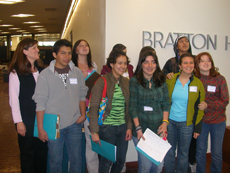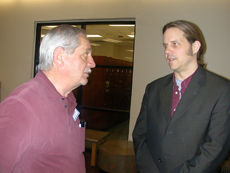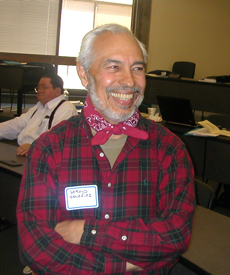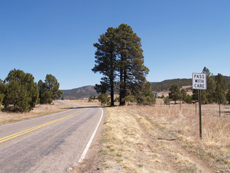 |
|
|
Volume XIII |
May 2008 |
Number V |
|
|
University of New Mexico Law School Land Grant SymposiumCitizen Groups Appeal Forest Service and BLM Decision on Buckman Diversion Project By Kay Matthews Puntos de Vista: Guadalupita Community Wins Battle to Save Old Growth Pines By Malcolm Ebright |
Editorial: LANL Needs to Clean Up Its Mess, Not Add To It By Mark SchillerCongressman Tom Udall Introduces Bill to Compensate LANL Workers |
University of New Mexico Law School Land Grant SymposiumMany familiar faces turned out for the April 12 Land Grant Symposium sponsored by the University of New Mexico Law School. Natural Resources Journal student editor Kristina Fisher organized the forum that featured land grant researchers and activists who provided an overview of how many Spanish and Mexican land grants were unjustly adjudicated following the Mexican-American War. The symposium also included discussions of the controversial 2004 Government Accountability Office report that essentially obsolves the federal government of legal culpability in the adjudications of these land grants.
Students from Casey Mason and Ronda McQuade's class at Amy Biehl High School in Albuquerque
Joe Ciddio, director of the Oñate Monument and Visitors Center, and David Correia, one of the symposium presenters
UNM Law Professor Em Hall reading La Jicarita News
Juan Sanchez, president of the Land Grant Congreso
Gerald Gonzales, former Santa Fe County manager
Citizen Groups Appeal Forest Service and BLM Decision on BuckmanDiversion Project By Kay MatthewsThe City of Santa Fe, the County of Santa Fe, and Las Campanas Limited Partnership are counting on surface water from the Rio Grande to help meet their domestic water needs by 2020. They plan on diverting this water via the Buckman Water Diversion Project, and in October of 2007 the Forest Service and Bureau of Land Management, the agencies that manage the lands where the diversion and project pipelines are located, signed off on the Final Environmental Impact Statement (FEIS) that allows the project to go forward. However, Concerned Citizens for Nuclear Safety (CCNS) and Amigos Bravos have appealed that decision and are represented by Bruce Frederick of the New Mexico Environmental Law Center. In the Notice of Appeal Frederick points out that both CCNS and Amigos Bravos commented on the Draft EIS, arguing that the BLM and Forest Service (USFS) "failed to adequately evaluate or even consider any of the adverse environmental impacts that could foreseeably result if radionuclides or other water and soil contaminants emanating from the Los Alamos National Laboratory (LANL) were to migrate into the Rio Grande and enter the Buckman Diversion Project." BLM and the USFS responded "with minimal discussion" that the impact of such contaminant migration on water quality was "considered speculative." In the Notice of Appeal to the BLM (the appellants were required to issue separate USFS and BLM appeals) Frederick argues that the possible migration of contaminants is "reasonably foreseeable" and not speculative. He cites a letter, dated November 1, 2007, from County Commissioner Harry Montoya, who is Chair of the Buckman Direct Diversion Board (BDD Board), to the National Nuclear Security Administration, the Department of Energy's nuclear weapons agency, requesting cooperation to "stop continued migration of LANL-origin waste to the environment, mitigate the impacts of wastes that have escaped the LANL boundaries and are in the environment at the location of the proposed BDD (Buckman Direct Diversion), and otherwise reduce the burden and costs that these wastes place on our regional drinking water project." In fact, CCNS and other concerned citizens have been meeting on a regular basis with the BDD Board and Rick Carpenter, City of Santa Fe Water Resources Coordinator and Buckman Project Manager, to provide specific information about present and potential contaminants in the Rio Grande. Their input raised enough concern that a July 26, 2007 memo from Carpenter, Robert Gallegos, City Utilities Compliance Officer, and Norman Gaume, a BDD consultant, used the same language as the November 7 letter, to ask the Lab to "Stop migration of LANL contaminants to the Rio Grande and to groundwater." The three areas of concern addressed in the memo are: transuranic and other radiological contaminants, such as plutonium, discharged from LANL in the 1940s through the 1960s that has been deposited in sediments adjacent to the BDD facilities; contaminants in the Rio Grande, including radiological contaminants and other toxic wastes from historical and current releases and waste discharges; and contaminants that have reached the regional aquifer that underlies LANL and provides water to the Buckman well field. In response to the first concern, the Board contends that the diversion will not disturb the contaminated sediment and it will remain in place. With regard to contaminants in the river water, the Board claims the "robust treatment processes" that will be employed at the diversion Treatment Plant will block and remove these contaminants. This treatment will be complimented by, if necessary, a temporary cessation of diversions during runoff events that are likely to transport contaminants to the Rio Grande. And finally, the Board claims that the levels of transuranic contamination in Buckman wells are so low "that signals from the analytical instruments are almost indistinguishable from the background 'noise'" and questions the validity of detections in the well field. The appellants contend that while the Treatment Plant is required to meet Federal Drinking Water Standards, many LANL contiminants don't have standard requirements. The Treatment Plant will employ a microfiltration system rather than a nanoparticulate system, which the appellants believe is the only way to prevent radionuclides that are carried in water in nanoclusters from passing through the system. According to a new study at the Department of Energy's Argonne National Laboratory, nanoclusters of plutonium ions are very difficult to remove from the groundwater. The BDD Board responded to the BLM appeal by asking for a summary dismissal because the appellants failed to serve a copy of the Notice of Appeal to the Board. But as Frederick points out in his response to this request, the Board has no standing to participate in the appeal, which is directed to the United States Interior Board of Land Appeals. The appellants are asking the BLM to stay implementation of its decision to grant certain rights-of-way to the BDD. The USFS has alreday denied the appeal and the appellants will now have to take their case to court Puntos de Vista: Guadalupita Community Wins Battle to Save Old Growth PinesBy Malcolm EbrightAfter a concerted grass roots campaign that involved historical research, petition signing, and direct action, the New Mexico Department of Transportation notified Guadalupita residents that the three large old growth ponderosa pines slated to be cut down as part of a road improvement project on State Highway 434 would not be cut. The trees are a landmark known by most people in the Mora/Guadalupita area and are used to give directions to those turning off 434 on to the dirt road variously known as Coyote Loop, the Three Pines Road, or County Road A020. Residents told their visiting friends: turn at the three pines; some said the general area was known as the Three Pines area.
Two hundred and two local residents signed a petition to the Department of Transportation asking that these 100 year-old trees be spared the fate of the other trees on the right-of-way. The petition's statement that "these trees are a significant landmark and greatly valued by the local community" was borne out by the number of people who enthusiastically signed the petition and who came forward with stories about their memories of the trees. As the week of April 21, 2008 began it looked like the trees would be cut by the road crew, executing plans laid by the NM Transportation Department many months earlier. We began making "Save the Three Pines" signs when it dawned on us that the highway department might just cut them down. When DOT spokesmen and decision-makers told us they probably would cut them down because they constituted a hazard (they could kill you if you ran into them), many of us resolved to draw a line in the sand. We didn't think it would be necessary, but if so, we would place ourselves between the trees and the chainsaws. While negotiations and discussions continued with the decision makers, we took shifts guarding the trees and getting petitions signed. As stories emerged about the historical and cultural value of the three pines we started writing them down. The most compelling story was from Lorenzo Herrera, who grew up only one-fourth mile from Three Pines. He told of a day he remembers well because it was the day his brother Francisco was born. Lorenzo and his grandmother (who raised him during his early years) were walking to his mother's house to see the new baby, when a violent windstorm came up and they took shelter among the three pines. Lorenzo produced a photograph of himself showing a six year-old boy dressed in a cowboy outfit standing in front of the three pines, which were already sizeable on October 13, 1951. 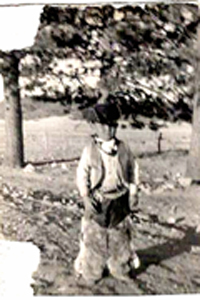 Lorenzo signed an affidavit, which we e-mailed with the photo and the first batch of petition signatures to the Highway Department decision makers at mid-week. Word came back that they probably would not cut the three pines, but that was not definitive until they had completed an investigation. In the meantime, the Highway Department received inquiries from State Representative Tomás Garcia and U.S. Congressman Tom Udall, and a story appeared in the Las Vegas Optic headlined "Trees Saved: For Now." The Highway Department placed a small fence around the trees and told us we could go home because the trees would be protected, at least for now. We didn't have any idea how long the temporary situation would last, when the investigation would take place, or if we could be part of it, so we stayed. We continued to guard the trees in shifts, getting more signatures and encouragement from the community all the time. Everyone was smiling at us but the Highway Department workers. On Thursday morning at 8:30 a.m. the Highway Department called us to say they would not cut down the three pines. We couldn't believe it, and some continued to stand guard until the Las Vegas Optic reported that Highway Department District Engineer Paul Gray "decided to save the trees on the recommendation of the department's environmentalist." We had won! On reflection we realized that the trees had won. Certainly the two hundred and two local residents who petitioned the Highway Department can savor a victory of cultural and historical values over the somewhat absurd mindset that viewed these trees as hazardous. But from the standpoint of the trees this was a bittersweet victory. Many other trees were cut - more than were necessary. Today the trees on the left in the photo above are gone. The Highway Department had received requests to save those and other trees, but was unwilling to make any more exceptions to its "cut them all" policy. In pondering the fate of these beautiful old growth trees, we learned several lessons that we would do well to remember. We can't take anything that we treasure for granted. We are thinking of establishing a Historic District to protect our community from the next onslaught. This time we were saved by grassroots action and grassroots history. Next time we had better be prepared with this history. We have to take the time to conduct more oral history interviews with people like Lorenzo Herrera, to dig up more old photos and use them to jog the memories of the elders whose stories will be lost if steps are not taken to preserve them. We have learned that history has the power to preserve and protect a community. In a variation on a famous quotation, we have learned that those who do not know their history are doomed to lose it.1 The Guadalupita Community is deeply grateful for the support throughout the Mora area for this important cause. If we are planting more trees to help reverse global warming, if we are discouraging clear-cutting in our national forests, and saving thousand year-old redwoods in California, why wouldn't we want to save this important land mark. Mil gracias a todos.
1 George Santayana (1863-1952) wrote "Those who cannot remember the past are condemned to repeat it." The Life of Reason (1905) vol. 1, Chapter 12.
|
LETTERSDear La Jicarita News, Thank you for covering the latest events around the DOE's proposal for Complex Transformation in the article by Mark Schiller entitled "Community Speaks Out: LANL Expansion Proposal," April 2008. Unfortunately an error has been made in reporting, one that has the potential to be very damaging to the Embudo Valley growers and gardeners, to Picuris Pueblo and the credibility of the Embudo Valley Environmental Monitoring Group (EVEMG.) It was not stated in the presentation made at NNMC event: that contaminants from LANL have migrated down wind into the gardens in the Embudo Valley and homes at Picuris Pueblo. Although the projects conducted by EVEMG have uncovered contamination of concern in certain areas of the watershed, specifically the Trampas Lake area, irrigation water and soils have not shown evidence that specific Embudo Valley gardens are adversely affected or that contamination is wide spread at Picuris Pueblo. What our findings represent is that more information is necessary in order to definitively determine the extent and the pathways of contamination. This can only be obtained through further monitoring and expanded watershed and residential dust sampling programs. EVEMG is working to understand the relationship between our air shed and the watershed. This can be accomplished through the support of our community and our relationships with funding and governing agencies. These relationships have been built up over years and are greatly appreciated. We work to maintain our hard-earned credibility with the individuals, communities and agencies. Our good relationships serve to further these sampling projects as does the sensitive way we present this information to the communities. Our land based communities rely on clean air, water and land both socially and economically. We remain very concerned that LANL is not addressing legacy and ongoing waste issues and continues to spread unmitigated contamination. EVEMG is vigilantly working to address the pollution in our communities in a way that requires LANL to address cleanup, and provide remediation and restoration that in turn will limit further migration of contamination as well as promote life-affirming science and activities. EVEMG would like to thank Mark Schiller for covering the informational seminar for the community but we have to stress that it is not EVEMG's position that the produce that we grow in our gardens is contaminated or unsafe for consumption. Sincerely, Sheri Kotowski Yesca Sullivan Embudo Valley Environmental Monitoring Group Editorial: LANL Needs to Clean Up Its Mess, Not Add To ItBy Mark SchillerIn 2005 the Department of Energy (DOE) signed a Consent Order with the New Mexico Environment Department (NMED) to clean up approximately 700 sites on Los Alamos National Laboratory (LANL) property that have been contaminated by nuclear and other hazardous waste. As part of that agreement the National Nuclear Security Administration (NNSA), a division of DOE that's administering the cleanup, agreed to a schedule for the remediation work that includes yearly benchmarks. A recent report by the DOE's Inspector General, Gregory H. Friedman, however, states, " . . . it is unlikely that the department will complete certain long-term remediation activities at Los Alamos in accord with existing requirements." While the Inspector General's report suggests that some of these delays are being caused by logistical problems that were unanticipated when the schedule was created, the real problem, it concedes, is that "Funding has not been sufficient . . . to carry out all the work necessary to meet requirements." The report goes on to say, "Delays in completing the substantial remediation work associated with the cleanup milestones may increase the risk of employee and public exposure to contaminants. Furthermore, such delays are likely to increase [the cost of] the overall environmental budget." Even New Mexico Senator Pete Domenici, who has previously done substantial damage control regarding accusations of mismanagement and incompetence at LANL, has been critical of the budgetary shortfalls stating, "The $100 million shortfall in the FY [fiscal year] 2009 budget is unsuitable and unacceptable . . . ." Ironically, at the same time that DOE is claiming that a lack of funding is handicapping these remediation efforts, it seems to be able to obtain abundant funding for the construction of a new Chemical and Metallurgy Research Replacement (CMRR) facility at LANL that will be used to "support" renewed plutonium pit production at the adjacent PF-4 building (the two buildings are linked by underground tunnels and DOE is also seeking funding for a massive expansion of the PF-4 facility). According to Nuclear Watch New Mexico Director Jay Coghlan, the initial budget of $655 million for CMRR, which was supposed to include cost of living increases, has already skyrocketed to over $2 billion. However, when the DOE recently solicited public comment for its proposed "Draft Complex Transformation" (formerly known as "Complex 2030" and colloquially referred to as "Bombplex"), a plan to dramatically "upgrade" the nuclear weapons stockpile, 90% of the comments suggested the United States is already "violating the Nuclear Non-Proliferation Treaty (NPT) . . . and should assess an additional alternative &endash; disarmament in compliance with NPT&endash; and not design or build new nuclear weapons." As La Jicarita News has previously reported, recent scientific studies demonstrate that the current stockpile of nuclear warheads and triggers have at least a 100-year life span and are not "outdated." Moreover, new pit production will unquestionably result in increased future contamination. While LANL continues to build its new CMRR facility, pit production "support" work is being carried out at the existing 55-year-old CMR facility, which the Defense Nuclear Facilities Safety Board (DNFSB) has already acknowledged, "is known to have serious vulnerabilities, such as the lack of robust building confinement to prevent a release of radioactivity during an accident." The DNFSB report goes on to say it "believes that continued operation of the CMR facility in its current condition poses significant risks to workers and the public." Apparently the DOE feels that these are acceptable risks, as it has constructed fifteen new pits in the last year. Coghlan estimates that when the facility is in full operation "the total costs for LANL's plutonium pit production will be over a half-billion dollars per year." How, you may well ask, is it possible for the DOE to channel all this money into production of new facilities for unnecessary plutonium pits and nuclear weapons when the DOE can't find the money to clean up the mess it's made over the last sixty-plus years at LANL? According to an April 30, 2008 letter that Concerned Citizens for Nuclear Saftey (CCNS) Director Joni Arends and Registered Geologist Richard H. Gilkeson sent the DOE regarding "Bombplex", the DOE's 2009 budget request to Congress includes "more money for nuclear weapons than for 'science' and 'energy' combined." The letter goes on to state, "This drain on our national economy and our scientific and engineering talent must stop. It is irresponsible of the DOE to pursue a new program to design and manufacture 'state of the art' nuclear weapons with the United States facing both an energy emergency and a fiscal spending emergency. The economy of the United States is being devastated by the runaway costs of energy and the military mission in Iraq. The DOE . . . must [change its] mission from 'new nuclear weapons for national security' to research and development across the spectrum of energy resources and especially renewable energy resources, which will provide real national security. The plan to transform LANL into a plutonium pit factory is a mistake. Instead, LANL must be transformed into a new center of excellence across the spectrum of non-proliferation, basic science and cleanup, restoration and remediation technologies." While Senator Domenici, who over the course of his six terms in Congress has channeled billions of dollars in pork barrel money to LANL defense-related projects, bears most of the responsibility for this unjustified spending, Senator Bingaman also sits on the Defense Committee, which controls LANL funding. A recent press release from Senator Bingaman, in my opinion, attempts to put a "good spin" on the FY 2009 budget's proposed increased funding for LANL. For example, he suggests that an additional $50.2 million for CMRR will be used to "support [plutonium] pit manufacturing operations, but [is] not actually being used to manufacture pits." This seems to me to be splitting hairs, as the pit manufacturing facility (PF-4) is right next to CMRR and the DOE, as previously noted, is seeking funding for a upgrade of the PF-4 facility as well. So while there won't actually be pit production in CMRR, the research and refinement of plutonium done there facilitates increased pit production at LANL. The press release also states that the bill seeks $46 million "in upgrades to safeguards for storing nuclear materials at LANL." The implication is that LANL will "upgrade" safety standards for its current plutonium stockpile, but the reality, according to Jay Coghlan, is that LANL needs this money to "safeguard" the increased weapons grade plutonium it's creating for new pits. Finally, the press release states that the bill seeks "$229.56 million for clean up funding for LANL, an increase of $67.1 million." However, even Senator Domenici, as already noted, has conceded that the initial 2009 budget was $100 million short of meeting the Consent Order's 2009 benchmarks, and Jay Coghlan suggests that even with the $67.1 million increase, the funding will fall $100 million short of meeting the FY 2009 benchmarks. In the meantime, anti-nuclear activists are concerned that radioactive and other toxic materials from LANL are migrating into the Rio Grande (soon to be the main source of drinking water for both Albuquerque and Santa Fe, see article, page 3) and that an expensive system of monitoring wells LANL installed to meet the provisions of the Consent Order and the Resource Conservation and Recovery Act is not doing an adequate job of tracking the pollutants. The previously referenced April 2008 letter from CCNS Director Arends and geologist Gilkeson asserts, among other things: 1) The wells are installed too far away from LANL legacy waste dumpsites and in geologic formations with low permeability, where groundwater contamination is not likely to be present; 2) Well screens dilute and mask groundwater contamination because they are too long; and 3) Use of organic drilling fluids and bentonite clay drilling muds mask the presence of radionuclides. So even some of the measures LANL is taking to comply with the Consent Order are not effectually addressing the on the ground problems Let's face it, LANL is New Mexico's federal cash cow and despite the fact that it's poisoning the land, water, and air, and many of its operations are in violation of the Nuclear Non-Proliferation Treaty, it's essentially invulnerable. Although Senator Bingaman and Congressman Udall have voiced their desire to change LANL's mission to development of alternative energy sources and remediation of nuclear and other hazardous waste, no one in the Congressional delegation is prepared to put his or her political career in jeopardy by being outspoken in the condemnation of continued increased defense spending. In point of fact, while I was writing this article, we received "The Final Site-Wide Environmental Impact Statement for Continued Operation of Los Alamos National Laboratory." It's thousands of pages long, cost millions of dollars to research and write (postage alone for the thousands of copies that were sent out amounts to $28.60 per copy), and lists three alternatives: No Action; Reduced Operations; and Expanded Operations, which would fund "projects that add new or expand existing capabilities at LANL" (i.e. dramatically expand plutonium pit production facilities). Guess which one is the preferred alternative. The ultimate irony is the public, as it did with the Complex Transformation proposal, will respond overwhelmingly against the proposed expansion, the DOE will spend millions of dollars detailing how it will "mitigate" all the public's concerns, and activist groups will then have to raise millions of dollars to challenge the DOE's "final" decision to expand operations in court. Meanwhile the DOE will use our tax dollars to defend its decision. In other words, it's business as usual up on the "Hill." News Updates
|
Home | Current Issue | Subscribe | About Us | Environmental Justice | Links | Archive | Index
Copyright 1996-2006 La Jicarita Box 6 El Valle Route, Chamisal, New Mexico 87521.

